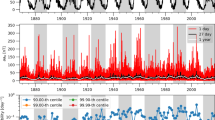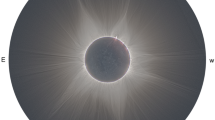Abstract
Based on synoptic magnetic maps, we use spherical harmonic functions to decompose the global magnetic field of the Sun. Through the expansion coefficients, the power spectrum \(C_{l}\), and its zonal component \(C_{l}^{Z}\) and sectorial component \(C_{l}^{S}\) for order \(l\) are defined. Through two sampled synoptic maps, it is easy to show that the multipole moments in solar active years are much stronger than those in the quiet years. We decomposed the synoptic maps for Carrington rotations (CRs) 1625 to 2224, i.e., corresponding Solar Cycles 21 – 24, and studied the evolution of multipole moments. Except for the monopole, the power spectra \(C_{l}\) for most moments have an obvious 11-year period. The dipole and octupole in Solar Cycle 22 are much stronger than in the other three cycles. The zonal components of dipole and octupole are opposite to the phases of most modes, while the sectorial components of them are consistent with most phases. In addition, compared to the phase of the yearly sunspot number, the phases of most multipoles are relatively delayed, except for the zonal modes of the quadrupole and 32-pole (\(l=5\)). We find that the zonal mode of \(l=5\) is very strong, which leads ahead of the phase of the yearly sunspot number for about 10 CRs. Additionally, unlike the other modes, it has a strong 5.5-year period. Then, the zonal mode of \(l = 5\) is mainly induced by the magnetic field of the sunspots, which is further confirmed in this work.






Similar content being viewed by others
Data Availability
The data used in this work are all publicly available. The synoptic maps can be downloaded from: NSO/Kitt Peak (https://solis.nso.edu/kpvt/synoptic/), SOHO/MDI and SDO/HMI (http://hmi.stanford.edu/data/synoptic.html). The yearly mean total sunspot number can be downloaded from SIDC (https://www.sidc.be/silso/).
Notes
References
Altschuler, M.D., Trotter, D.E., Newkirk, J.G., Howard, R.: 1974, The large-scale solar magnetic field. Solar Phys. 39, 3. DOI. ADS.
Choudhary, D.P., Ambastha, A., Ai, G.: 1998, Emerging flux and X-class flares in NOAA 6555. Solar Phys. 179, 133. DOI. ADS.
de Patoul, J., Inhester, B., Cameron, R.: 2013, Polar plumes’ orientation and the Sun’s global magnetic field. Astron. Astrophys. 558, L4. DOI. ADS.
DeRosa, M.L., Brun, A.S., Hoeksema, J.T.: 2011, Dipolar and quadrupolar magnetic field evolution over solar cycles 21, 22, and 23. In: Brummell, N.H., Brun, A.S., Miesch, M.S., Ponty, Y. (eds.) Astrophysical Dynamics: From Stars to Galaxies 271, 94. DOI. ADS.
DeRosa, M.L., Brun, A.S., Hoeksema, J.T.: 2012, Solar magnetic field reversals and the role of dynamo families. Astrophys. J. 757, 96. DOI. ADS.
Djurović, D., Pâquet, P.: 1996, The common oscillations of solar activity, the geomagnetic field, and the Earth’s rotation. Solar Phys. 167, 427. DOI. ADS.
Domingo, V., Fleck, B., Poland, A.I.: 1995, The SOHO mission: an overview. Solar Phys. 162, 1. DOI. ADS.
Gokhale, M.H., Javaraiah, J., Kutty, K.N., Varghese, B.A.: 1992, Global modes constituting the solar magnetic cycle - part one. Solar Phys. 138, 35. DOI. ADS.
Harvey, K.L., Zwaan, C.: 1993, Properties and emergence patterns of bipolar active regions - part one. Solar Phys. 148, 85. DOI. ADS.
Juckett, D.: 2003, Temporal variations of low-order spherical harmonic representations of sunspot group patterns: evidence for solar spin-orbit coupling. Astron. Astrophys. 399, 731. DOI. ADS.
Juckett, D.A.: 2006, Long period (0.9 5.5 year) oscillations in surface spherical harmonics of sunspot longitudinal distributions. Solar Phys. 237, 351. DOI. ADS.
Knaack, R., Stenflo, J.O.: 2005, Spherical harmonic decomposition of solar magnetic fields. Astron. Astrophys. 438, 349. DOI. ADS.
Liu, Y., Hoeksema, J.T., Scherrer, P.H., Schou, J., Couvidat, S., Bush, R.I., Duvall, T.L., Hayashi, K., Sun, X., Zhao, X.: 2012, Comparison of line-of-sight magnetograms taken by the Solar Dynamics Observatory/Helioseismic and Magnetic Imager and Solar and Heliospheric Observatory/Michelson Doppler Imager. Solar Phys. 279, 295. DOI. ADS.
Livshits, I.M., Obridko, V.N.: 2006, Variations of the dipole magnetic moment of the sun during the solar activity cycle. Astron. Rep. 50, 926. DOI. ADS.
Mackay, D.H.: 2012, The Sun’s global magnetic field. Phil. Trans. Roy. Soc. London Ser. A, Math. Phys. Eng. Sci. 370, 3151. DOI. ADS.
Mikhaylutsa, V.P.: 2020, The hidden cycle of the solar tesseral-quadrupole magnetic field. Solar Phys. 295, 67. DOI. ADS.
Obridko, V.N., Sokoloff, D.D., Shelting, B.D., Shibalova, A.S., Livshits, I.M.: 2020, Cyclic variations in the main components of the solar large-scale magnetic field. Mon. Not. Roy. Astron. Soc. 492, 5582. DOI. ADS.
Obridko, V.N., Pipin, V.V., Sokoloff, D., Shibalova, A.S.: 2021a, Solar large-scale magnetic field and cycle patterns in solar dynamo. Mon. Not. Roy. Astron. Soc. 504, 4990. DOI. ADS.
Obridko, V.N., Sokoloff, D.D., Pipin, V.V., Shibalva, A.S., Livshits, I.M.: 2021b, Zonal harmonics of solar magnetic field for solar cycle forecast. J. Atmos. Solar-Terr. Phys. 225, 105743. DOI. ADS.
Pesnell, W.D., Thompson, B.J., Chamberlin, P.C.: 2012, The Solar Dynamics Observatory (SDO). Solar Phys. 275, 3. DOI. ADS.
Petrie, G.J.D.: 2013, Solar magnetic activity cycles, coronal potential field models and eruption rates. Astrophys. J. 768, 162. DOI. ADS.
Pipin, V.V., Moss, D., Sokoloff, D., Hoeksema, J.T.: 2014, Reversals of the solar magnetic dipole in the light of observational data and simple dynamo models. Astron. Astrophys. 567, A90. DOI. ADS.
Scherrer, P.H., Bogart, R.S., Bush, R.I., Hoeksema, J.T., Kosovichev, A.G., Schou, J., Rosenberg, W., Springer, L., Tarbell, T.D., Title, A., Wolfson, C.J., Zayer, I., MDI Engineering Team: 1995, The solar oscillations investigation - Michelson Doppler Imager. Solar Phys. 162, 129. DOI. ADS.
Scherrer, P.H., Schou, J., Bush, R.I., Kosovichev, A.G., Bogart, R.S., Hoeksema, J.T., Liu, Y., Duvall, T.L., Zhao, J., Title, A.M., Schrijver, C.J., Tarbell, T.D., Tomczyk, S.: 2012, The Helioseismic and Magnetic Imager (HMI) investigation for the Solar Dynamics Observatory (SDO). Solar Phys. 275, 207. DOI. ADS.
Schmieder, B., Hagyard, M.J., Guoxiang, A., Hongqi, Z., Kalman, B., Gyori, L., Rompolt, B., Demoulin, P., Machado, M.E.: 1994, Relationship between magnetic field evolution and flaring sites in AR 6659 in June 1991. Solar Phys. 150, 199. DOI. ADS.
Solanki, S.K., Schüssler, M., Fligge, M.: 2000, Evolution of the Sun’s large-scale magnetic field since the Maunder minimum. Nature 408, 445. DOI. ADS.
Stenflo, J.O., Guedel, M.: 1988, Evolution of solar magnetic fields - modal structure. Astron. Astrophys. 191, 137. ADS.
Stenflo, J.O., Vogel, M.: 1986, Global resonances in the evolution of solar magnetic fields. Nature 319, 285. DOI. ADS.
Sun, X., Liu, Y., Hoeksema, J.T., Hayashi, K., Zhao, X.: 2011, A new method for polar field interpolation. Solar Phys. 270, 9. DOI. ADS.
Wang, Y.-M.: 2004, The Sun’s large-scale magnetic field and its long-term evolution. Solar Phys. 224, 21. DOI. ADS.
Zhu, F.R., Jia, H.Y.: 2018, Lomb-scargle periodogram analysis of the periods around 5.5 year and 11 year in the international sunspot numbers. Astrophys. Space Sci. 363, 138. DOI. ADS.
Zieger, B., Virtanen, I., Mursula, K.: 2019, Spatial power spectrum of the photospheric magnetic field during solar minimum. Astron. Astrophys. 623, A51. DOI. ADS.
Acknowledgments
We acknowledge NSO/Kitt Peak, SOHO and SDO for providing the solar magnetic field data. NSO/Kitt Peak data used here are produced cooperatively by NSF/NOAO, NASA/GSFC, and NOAA/SEL. SOHO is a project of international cooperation between ESA and NASA. SDO data are a courtesy of SDO (NASA) and the HMI, AIA, and EVE science teams. The MDI and HMI data are obtained from the Joint Science Operations Center at Stanford University. We acknowledge the sunspot data from SILSO, Royal Observatory of Belgium, Brussels.
Funding
This work is supported by Scientific Research Foundation for High-level Talents in NJCIT (YB20211501).
Author information
Authors and Affiliations
Contributions
Z.C.: initial idea, code design, writing of the manuscript. W.W.: data preprocessing, revision of the manuscript. H.G.: data collection and preprocessing. All authors participated in the analysis and discussion of the results.
Corresponding author
Ethics declarations
Competing interests
The authors declare no competing interests.
Additional information
Publisher’s Note
Springer Nature remains neutral with regard to jurisdictional claims in published maps and institutional affiliations.
Rights and permissions
Springer Nature or its licensor (e.g. a society or other partner) holds exclusive rights to this article under a publishing agreement with the author(s) or other rightsholder(s); author self-archiving of the accepted manuscript version of this article is solely governed by the terms of such publishing agreement and applicable law.
About this article
Cite this article
Chu, Z., Wang, W. & Gu, H. The Evolution of Multipole Moments for the Global Solar Magnetic Field. Sol Phys 298, 71 (2023). https://doi.org/10.1007/s11207-023-02168-9
Received:
Accepted:
Published:
DOI: https://doi.org/10.1007/s11207-023-02168-9




